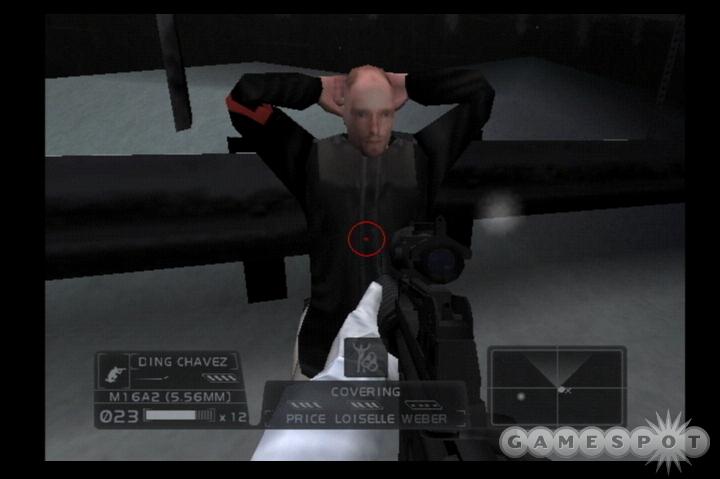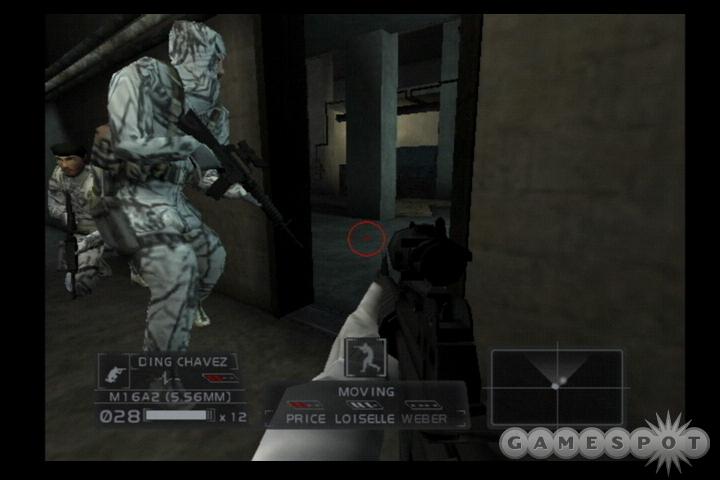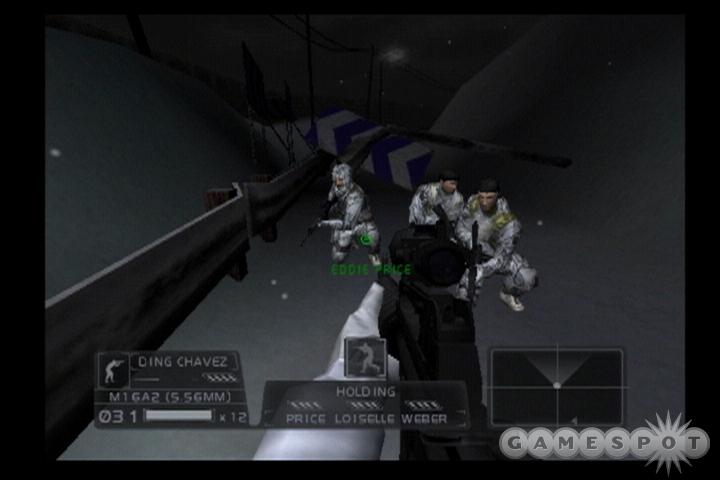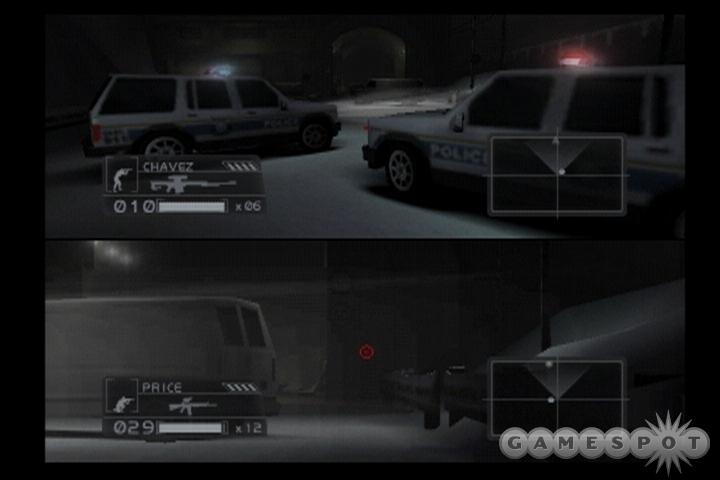There's no negotiating with terrorists in Tom Clancy's Rainbow Six 3. As an elite counterterrorist operative, you and your team will be called upon to settle highly sensitive situations with decisive force. Armed with your choice of the world's deadliest firearms, you'll neutralize the enemy and rescue any hostages, then leave without a trace. Tactical squad-based shooters, such as Rainbow Six 3, aren't uncommon at this point, though the Rainbow Six series, which debuted on the PC in 1998, has been instrumental in solidifying this popular style of gaming. Rainbow Six 3 for the PlayStation 2 is a port of last year's Xbox game of the same name, which itself was a translation of the PC shooter Rainbow Six 3: Raven Shield. While this latest version still offers a considerable variety of challenging enemy-infested missions, online play, and a great selection of carefully modeled real-world weapons, and it also features some new missions and a pretty good split-screen mode, it's marred by substandard graphical performance, long loading times, and artificial intelligence issues, and it simply isn't as impressive as its counterparts on other platforms. On its own merits, though, it can still be a tense and exciting first-person shooting experience.

Rainbow is the name of author Tom Clancy's fictional counterterrorist unit, composed of the world's strongest, fastest, most highly trained sharpshooters and commandos. Basically, Rainbow is deployed to clean up big messes when there's no other recourse. Like other Rainbow Six titles, Rainbow Six 3 is a shooter, set in the real world, that strives for realism. Death comes swiftly, as just one or two bullets will be enough to take out most targets, and you yourself can't sustain much damage either. Tactics, initiative, and the element of surprise are your greatest weapons, though the submachine guns and assault rifles are pretty handy too. You cannot jump, and you cannot sprint. Unfortunately, you cannot lie prone, but you may crouch and move while crouched, which is often the best course of action. Your "special powers" are limited to an onscreen map of your surroundings, which also reveals the direction from which you're taking fire. You get night vision and thermal vision too. Your means of attack are limited to the primary and secondary weapons and grenades that you choose to bring with you into a mission, and, for reasons that aren't terribly clear, you cannot pick up and use any weapons dropped by those who've been shot. So, in essence, Rainbow Six 3 is a simple game of kill-or-be-killed. You'd better learn to aim faster and truer than your enemies.
The game features a pretty good variety of modes for play, both online and off. There's a linear, single-player campaign, featuring more than a dozen missions and three levels of difficulty (all of which, in fact, are challenging). In the campaign, you play as Domingo "Ding" Chavez, Rainbow's best. At your side will be up to three other Rainbow operatives per mission. The campaign features an overarching storyline, involving South American terrorists, and other political intrigue that you'd expect from Tom Clancy. The missions themselves take place all over the world, in the sorts of mundane yet tactically intriguing settings you'd expect, from airports to chateaus. They tend to be packed with tangos, as well as a few hostages and maybe a few bombs, which you'll need to take care of or else the mission fails.
The missions aren't lengthy, per se, but since they're difficult, they can take a while. You and your team can't survive more than a few hits. Team members who are "incapacitated" by gunfire will be out for the remainder of that mission, though they'll magically return in subsequent missions. And if Ding dies--game over. Unlike in the Xbox version of the game, you cannot manually save your progress during the missions, though your progress will automatically be saved at various checkpoints. These can feel as though they're few and far between, however. The missions themselves are quite heavily scripted, so a trial-and-error process can eventually see you through if you aren't quick enough to react to the surprises around every corner.
Some of the enemies are crack shots, and some will use grenades, but their artificial intelligence can be pretty spotty. They'll run headlong into certain death sometimes, though on other occasions, you'll see them spraying bullets blindly from behind cover. They'll also exhibit other actions more along the lines of what you'd expect from a bunch of armed thugs. Likewise, your own teammates are prone to impressive feats of tactical expertise, as well as incredible stupidity. When ordered to hold position, they'll logically cover the area from every angle. They'll enter rooms while watching one another's back, and, in many cases, they'll save your hide. However, sometimes they'll throw grenades down at their feet, and sometimes they'll get stuck trying to get past one another. They'll also shout things to you long after the fact. Rainbow Six 3 is a realistic game, in general, so these occasional AI flukes tend to really stick out.
In addition to the campaign, there's also a cool "custom mission" option, which lets you delve into any of the levels you've seen in the campaign to take on enemies who will appear in different places each time. This adds some pretty good single-player replay value, since the core action of the game is pretty good. Unlike its Xbox counterpart, Rainbow Six 3 for the PS2 also features a two-player split-screen mode, allowing you and a friend to attempt any of the missions you've beaten in the campaign. The split-screen mode works pretty well; it strips away the weapon models in an attempt to remove clutter from the screen and keep the frame rate up. For what it's worth, if one player is killed, he or she is out of the fight until the other player dies, completes the mission, or restarts the mission, so in this mode, it especially pays to stick together and keep your head down.

Then there's the online component, which is one of the main attractions in Rainbow Six 3. Unfortunately, the online multiplayer mode is stripped down from the Xbox version. It supports up to six players in a match (down from the Xbox's 16 players) and offers just three modes of play (down from the Xbox's five), all of which are variations on the deathmatch. The sharpshooter mode is a timed match where you may respawn when killed, and whoever earns the most kills, wins. Survival and team survival require more patience, since they force you to sit out the rest of the round if you die, and whichever player or team is left standing is declared the winner. Unfortunately lacking are the Xbox version's online cooperative modes, though you do get the offline split-screen mode to compensate.
Online play is pretty straightforward, but it can be fun and visceral, though it lacks the objective-based multiplayer modes found in games like SOCOM II: U.S. Navy SEALs, which are popular for the good reason that they instill a sense of purpose in players that goes beyond just "kill all the other guys." We managed to get in on a number of good sessions that played smoothly, though at other times, we had to sit through one long loading sequence to get into a session, only to have to sit through a long loading sequence as we got bumped out. So, as the ESRB likes to point out, "game experience may vary during online play."
The Rainbow Six games have always been more serious than the average shooter. On the PC, the series attracted its own devoted following, separate from all the Quake and Unreal Tournament fans, because Rainbow Six wasn't just about shooting enemies--it was about commanding a team and executing a plan. These were relatively complicated elements, and not until now have they been made truly accessible. Single-player Rainbow Six 3 dispenses with the mission planning phase of previous Rainbow Six games, puts you in the role of the best of the best among Rainbow's ranks, and features a surprisingly intuitive, context-sensitive squad command system, which lets you issue orders to up to three other computer-controlled teammates. You just look at something and press the X button. Then your team will do what's natural, like advance to a new position, open a door and clear the next room, defuse a bomb, and so on. Sometimes there are more options available. For instance, pressing and holding X on a door allows you to order your team to toss a flashbang or frag grenade into the room before advancing. Or, if you'd prefer, you can order them to use a breaching charge to blow the door right open. You may also use what's called the "zulu go-code" to queue up an order for a specified time. The order is executed when you press one of the shoulder buttons, allowing you to coordinate simultaneous entry into a heavily fortified area. Additionally, the square button conveniently works as a toggle between ordering your team to form up behind you and ordering them to hold their positions.

Alternatively, much like the SOCOM games, Rainbow Six 3 allows you to give verbal orders to your AI-controlled team using a USB headset. Speak clearly, and your team will readily respond to simple orders, like "move" and "hold," as well as more complex orders, like "secure hostage" and "breach and clear." Your team will only respond to these and some other specific orders, so don't expect to be able to chat with them or anything. On the Xbox, you could optionally hear your team only through the headset, as opposed to the main speakers. Since the in-game characters are communicating via headsets already, hearing them over yours contributed a lot to the immersive feel of the game. Unfortunately, this is missing from the PS2 version, so really, the ability to give verbal orders is just an inefficient and gimmicky substitute for the optimal way of doing things.
Gun fanatics will love Rainbow Six 3's substantial variety of weapons. Various real-life pistols, submachine guns, assault rifles, sniper rifles, and light machine guns are each rated for accuracy, range, and power. You may fire any of these weapons from the hip, or you may use the scope if the weapon has one. You'll probably find that certain scoped submachine guns and assault rifles are far more effective than most of the other guns in the context of most of the game's scenarios, but, for the same reasons, such weapons are commonly used by real-life counterterrorist forces. The game features an interesting aiming system that, in a way, works opposite to what you'll find in games like Counter-Strike where your aiming reticle gets narrower when you're standing still to indicate that you'll be able to shoot within a more-precise area than if you were running around. In Rainbow Six 3, the aiming reticle is wider if you're standing still, and any enemy within this area will be auto-targeted. The reticle shrinks to a pinpoint when you're moving, forcing you to aim more precisely. This system works well with Rainbow Six 3, a console shooter that you can't play with the split-second pinpoint accuracy afforded by the mouse-and-keyboard controls used for PC shooters. Sadly, even with the generous auto-aim window, aiming in the PS2 version of Rainbow Six 3 tends to feel sluggish and awkward. This is one of those games where you'll blame the controls instead of your reflexes half the time you get killed.

Rainbow Six 3 for the PS2 doesn't look nearly as good as its counterparts on other platforms, but it doesn't look bad. Character animations are all right, in general, and the way tangos slump to the floor, lifeless, when struck by your fire is quite convincing. On the Xbox, you'd see blood splattered on the walls after a firefight or on the uniforms of injured team members, but such details are nowhere to be found here. Lighting and shadowing effects aren't so impressive, either, and animations for switching between weapons are really choppy. Enemy character models are also very simple yet can be hard to see from afar due to the game's low resolution. On top of all that, the game's frame rate chugs along at a clip that's never quite fast enough for comfort. While we're talking technical issues, it's worth reiterating that the game is plagued with lengthy loading times, which happen in between and during missions. These detract from the overall experience as long loading times always do.
As far as the audio is concerned, the weapon effects are certainly the highlight. These are some realistic-sounding guns, so you'd better keep the volume down or else a real-life counterterrorist unit might break into your home. The voice acting in the game is also well done. There's not much music in the game, save for a very nice opening theme and some slightly corny, sad-sounding acoustic guitar plucking that occurs when one of your team members is taken out. Unfortunately, there are a couple of really annoying sound effects for when you're injured; when you're low on health, you'll hear your character panting heavily as you run around, but it's just one sample looping repeatedly, and it's way too loud. When you're really low on health, you'll hear an obnoxiously loud heartbeat. It's enough to make you wish you could put a virtual bullet in your head. Or maybe that's just us.
Rainbow Six 3 for the PS2 does have some new content and features not found in other versions of the game, but they certainly don't compensate for the concessions that needed to be made to bring this game to Sony's platform. This can still be an exciting and visceral game of realistic shooting action, and the online play is pretty well executed, if you can get past the loading times. However, if you have the means to play Rainbow Six 3 on one of the other platforms, then this version is best avoided.